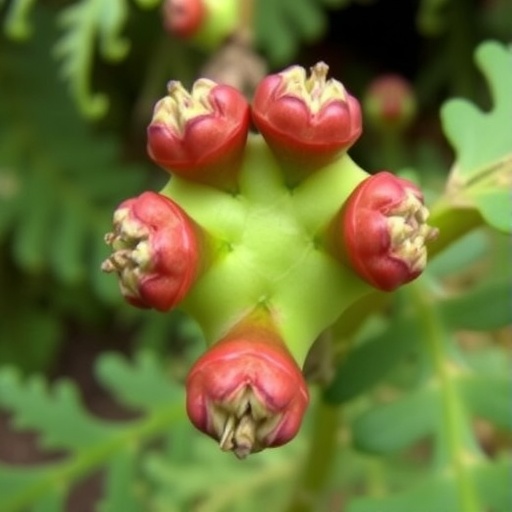In a compelling exploration of the often-overlooked relationship between plants and the organisms that induce galls upon them, a recent study has illuminated the unique structural, histochemical, and ecological features of lenticular leaf galls induced on the epiphytic fern Microgramma vacciniifolia. This research reveals not only the complex biological interactions at play but also emphasizes the broader implications these findings hold for understanding plant-pathogen dynamics and the intricate web of ecological relationships.
The research conducted by Ferreira, Godoy, Martins, and colleagues focuses on the structural characteristics of the galls formed on the leaves of Microgramma vacciniifolia, a fern notable for its epiphytic lifestyle. The team meticulously examined the morphological adaptations of these galls, which are outgrowths that develop as a result of the interaction between the host plant and gall-inducing organisms, often insects. This study offers a fascinating glimpse into how stress responses in plants can lead to the formation of these unique structures, which serve not only as protective capsules for the inducing organisms but also alter the plant’s growth and resource allocation.
Histochemical analyses conducted by the authors underscore the biochemical pathways involved in gall formation. The researchers utilized advanced techniques to analyze the cellular composition and chemical properties of the galls, identifying critical differences when compared to the leaf tissues of the host fern. These findings reveal how galls can possess unique elevations in certain metabolites, leading to hypotheses regarding potential defensive strategies employed by the host plant in response to the biological invasion. The study deepens our understanding of the physiological changes that transpire as a result of gall induction, a process that exemplifies the adaptability of plants to parasitic interactions.
Furthermore, the ecological ramifications of these galls cannot be overlooked. The phenomenon of gall formation introduces a range of interactions within local ecosystems, impacting not just the host fern, but the surrounding flora and fauna as well. As the researchers positioned their findings within the context of ecological networking, they highlighted how galls can serve as microhabitats for various microorganisms and other arthropods, thus facilitating a rich diversity of life forms. This symbiotic relationship showcases the nuanced interconnectedness that exists within ecosystems, governed by a myriad of biotic factors.
The researchers also probe into the evolutionary perspective of galls, suggesting that these structures might represent sophisticated survival strategies evolved over eons. By adapting to perturbations caused by gall-inducing organisms, the host ferns may be part of a co-evolutionary dance, wherein both plant and gall inducer shape each other’s evolutionary trajectories. The intricacies involved in this relationship prompt further questions about evolutionary ecology and the adaptive significance of plant responses to parasitism.
In the study, the team employed field studies complemented by laboratory experiments to cross-validate their findings, ensuring a robust body of evidence to draw conclusions. The dual approach provided a broad spectrum of insights into both natural and controlled environments, showcasing the versatility of Microgramma vacciniifolia as a subject of investigation. This methodological rigor lays the groundwork for future research into similar plant-gall interactions, as it demonstrates the potential to observe and document these phenomena in varied contexts.
Equally important is the study’s contribution to the conservation discourse. Understanding the role that such dynamic plant-gall relationships play within ecosystems can inform conservation strategies, particularly concerning vulnerable habitats where epiphytic ferns flourish. The authors argue that recognizing the implications of gall formation can aid in preserving ecological diversity and stability in increasingly threatened environments. The balance between plant resilience and vulnerability becomes a focal point when developing conservation initiatives.
The study’s findings are also particularly poignant in today’s context of rapid environmental change, where the significance of plant responses to biotic stressors like gall-inducing organisms may illuminate how ecosystems could adapt to fluctuating conditions. This line of inquiry raises essential questions about resilience in ecosystems and how such interactions might evolve as climate patterns and species distributions shift. The indicators gleaned from Microgramma vacciniifolia and its galls offer potential insights into broader ecological responses.
Moreover, the role of galls in influencing plant fitness arises as an intriguing thread woven throughout the research. The authors detail how galls can both detrimentally impact the host plant, often resulting in stunted growth or reduced reproductive success, while also conferring some benefits, such as shelter from herbivory. These dual effects underscore the complexity of ecological interactions, where the consequences of such relationships can oscillate between detrimental and beneficial.
The explorative nature of the research, blending structural and ecological insights, reinforces the notion that effective science communication needs to bridge the gap between specialized findings and public understanding. By delivering this knowledge in an engaging manner, the authors aim not only to inform but also to inspire a broader audience to appreciate the intricate narratives underpinning plant relationships with their environment.
In conclusion, the structural, histochemical, and ecological investigation of lenticular leaf galls induced on Microgramma vacciniifolia presents a significant advancement in our understanding of plant-gall interactions. The findings not only reveal the complexities of these relationships but also propel inquiries into the implications for ecosystems at large, contributing to the ongoing dialogue regarding sustainability and biodiversity conservation. This study is sure to set the stage for future explorations into the delicate balancing acts that define life on earth.
With a greater awareness of the underappreciated dynamics between plants and gall-inducing organisms, conservation efforts can be better aligned to support ecological integrity. As the research underscores, every interaction counts, and with each discovery, we move closer to understanding the intricate web that sustains life.
Subject of Research: Gall formation in epiphytic ferns.
Article Title: Structural, histochemical, and ecological peculiarities of lenticular leaf galls induced on the epiphytic fern Microgramma vacciniifolia (Polypodiaceae).
Article References:
Ferreira, B.G., Godoy, R.E.d.A.F., Martins, G.S. et al. Structural, histochemical, and ecological peculiarities of lenticular leaf galls induced on the epiphytic fern Microgramma vacciniifolia (Polypodiaceae). Sci Nat 112, 72 (2025). https://doi.org/10.1007/s00114-025-02023-w
Image Credits: AI Generated
DOI: https://doi.org/10.1007/s00114-025-02023-w
Keywords: Galls, Microgramma vacciniifolia, Ecology, Plant interactions, Histochemistry.




